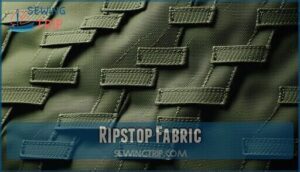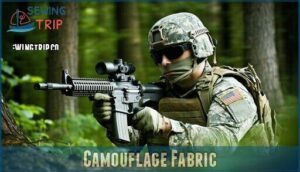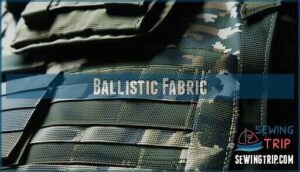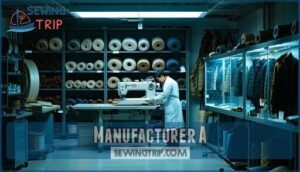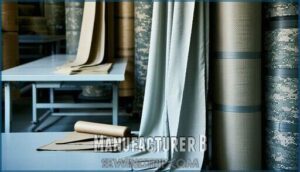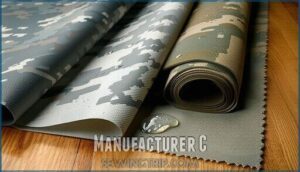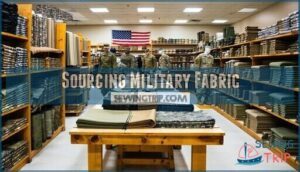This site is supported by our readers. We may earn a commission, at no cost to you, if you purchase through links.
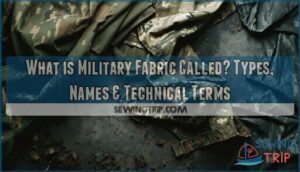
Ripstop fabric features reinforced threading that stops tears from spreading across the material.
Ballistic nylon provides puncture and tear resistance for body armor and tactical gear.
Camouflage fabric uses specialized weaving and dyeing for concealment.
Technical terms include NyCo (nylon-cotton blend) for uniforms, Nomex for fire resistance, and Kevlar for bulletproof applications.
These heavy-duty textiles evolved from basic cotton uniforms into advanced combat materials engineered for extreme conditions.
Each type serves specific military needs, from parachutes to protective clothing, combining durability with specialized performance features that keep personnel safe in combat environments.
Table Of Contents
Key Takeaways
- You’ll recognize military fabric by specific names like ripstop, ballistic nylon, and camouflage fabric – each designed for distinct tactical purposes and protection levels.
- Technical terms such as NyCo (nylon-cotton blend), Nomex (fire-resistant), and Kevlar (bulletproof) indicate precise fabric compositions engineered for specialized military applications.
- Military fabrics serve four primary functions: protection against threats, concealment through camouflage patterns, exceptional durability for harsh conditions, and comfort for operational mobility.
- You can source military fabric through specialized retailers, military surplus stores, and online suppliers, with options ranging from authentic mil-spec materials to commercial alternatives for civilian projects.
Military Fabric: an Overview
If you’ve ever wondered what to call those tough, specialized fabrics used in military gear, you’re not alone.
Military fabric goes by many names depending on its specific purpose and construction, from ripstop and ballistic fabric to technical textiles and performance materials.
Definition and Purpose
Military fabric represents specialized textiles engineered for combat environments and tactical operations. You’ll encounter these high-performance materials designed to withstand extreme conditions while protecting personnel.
When your life depends on your gear, military fabric delivers the protection and durability that keeps you mission-ready
Military textiles evolved from basic cotton uniforms to advanced combat materials incorporating cutting-edge technology.
These protective fabrics serve four primary functions:
- Protection – Shield against ballistic threats, flames, and environmental hazards
- Concealment – Provide camouflage patterns for tactical advantage
- Durability – Withstand harsh field conditions and repeated use
- Comfort – Allow mobility while maintaining protective properties
From nylon fabric in parachutes to ballistic fabric in body armor, military grade fabric continues advancing. Today’s tactical textile innovations combine synthetic fibers with specialized coatings, creating fabric types that outperform traditional materials in every measurable category.
The development of military fabrics also involves understanding fabric weave basics to optimize their performance and durability in various applications.
Types of Military Fabrics
Understanding military fabric types empowers you to choose the right material for your needs.
These specialized textiles fall into several key categories based on their protective properties and construction methods.
Ripstop fabric features reinforced threading that prevents tears from spreading, making it ideal for harsh conditions.
Camo textiles blend colors and patterns for concealment, while ballistic materials offer protection against projectiles.
Tactical fabrics combine multiple properties like water resistance and durability.
Combat threads often incorporate nylon fabric for strength and flexibility.
Each type serves specific military applications, from uniforms to equipment covers, ensuring soldiers stay protected and mission-ready in diverse environments.
Applications and Uses
You’ll discover military fabric serves countless applications beyond what meets the eye. From Combat Uniforms worn by Special Forces to Protective Clothing that saves lives, this tactical textile proves indispensable across military operations.
Military Equipment manufacturers rely on specialized combat material for diverse applications:
- Tactical Gear including backpacks, utility belts, and weapon accessories that withstand harsh conditions
- Ballistic fabric integrated into body armor, helmets, and vehicle protection systems
- Field equipment like tents, ponchos, and sleeping systems designed for extreme environments
Modern military uniforms incorporate advanced military fabric technologies that provide camouflage, flame resistance, and moisture-wicking capabilities. You’ll find these materials protecting personnel while maintaining operational effectiveness in demanding situations.
Common Names for Military Fabric
You’ll encounter military fabric under several common names that describe specific functions and features.
These names help identify the right material for different applications, from basic uniforms to specialized protective gear.
They are essential for ensuring the right material is chosen for the intended use.
Ripstop Fabric
You’ll recognize ripstop fabric by its distinctive crosshatch design that prevents tears from spreading.
That distinctive crosshatch pattern makes ripstop fabric virtually tear-proof in combat conditions
Originally developed during World War II for military parachutes, this tactical textile uses reinforced threads woven in grid patterns every 5-8 millimeters. The fabric weaving technique creates exceptional tear resistance while maintaining lightweight properties.
Ripstop fabrics are known for their tactical textile uses in various applications, including outdoor gear and activewear.
| Property | Specification |
|---|---|
| Thread Strength | 69+ Newtons (warp direction) |
| Grid Spacing | 5-8 millimeter intervals |
| Weight Range | 1.5-7 oz per square yard |
Modern ripstop nylon and ballistic fabric variants undergo rigorous durability tests, making them perfect for combat uniforms and gear where failure isn’t an option.
Camouflage Fabric
Camouflage fabric blends seamlessly into environments through specialized textile weaving and fabric dyeing techniques.
You’ll find various camouflage patterns like woodland, desert, and MultiCam designed for specific terrains.
These stealth materials use advanced concealment techniques, incorporating ripstop construction for durability.
Modern camouflage fabric combines cotton-nylon blends with fire-resistant properties, making it essential military fabric for uniforms, gear, and equipment across all branches.
Ballistic Fabric
While camouflage helps you blend into your environment, ballistic fabric keeps you protected when concealment isn’t enough.
You’ll recognize this heavyweight nylon material from World War II, when DuPont created it for military flak jackets.
Today’s ballistic fabric uses high-tenacity nylon in tight basketweave patterns, delivering exceptional strength against punctures and tears.
The choice of fabric is essential, considering factors like synthetic fiber types.
Modern ballistic protection offers you:
- Life-saving defense against shrapnel and projectiles in combat zones
- Unmatched durability for tactical gear that won’t fail when you need it most
- Proven performance tested through decades of military and law enforcement use
This material science marvel combines ripstop construction with Kevlar-like protection properties.
You’ll find ballistic fabric in body armor, tactical gear backpacks, and protective equipment where failure isn’t an option.
The high-tenacity nylon 6,6 fabric is a key component in the manufacture of ballistic fabric, providing enhanced strength and durability.
Technical Terms for Military Fabric
When you encounter technical military fabric terminology, you’ll find specialized names that reflect each material’s specific engineering properties.
These technical terms like NyCo, Nomex, and Kevlar indicate precise fabric compositions designed for distinct military applications requiring enhanced protection or performance characteristics.
NyCo (Nylon-Cotton Blend)
NyCo fabric represents the perfect marriage of two powerhouse materials in military textiles.
This nylon-cotton blend delivers the best of both worlds, combining nylon durability with cotton comfort for soldiers who can’t compromise on performance. You’ll find NyCo in military uniforms worldwide because it handles whatever you throw at it.
Key NyCo Properties that make soldiers feel unstoppable:
- Bulletproof durability – withstands harsh field conditions that destroy other fabrics
- All-day comfort – breathes like cotton so you stay cool under pressure
- Lightning-fast drying – gets you back in action when conditions get wet
- Battle-tested reliability – trusted by military forces who demand the absolute best
This fabric blend gives you the tactical advantage of synthetic strength without sacrificing the natural feel soldiers need during long missions.
Nomex (Fire-Resistant Fabric)
Why settle for ordinary protection when you can have fire-resistant fabrics like Nomex?
This meta-aramid material delivers exceptional thermal protection and burn prevention for military personnel.
Developed by DuPont, Nomex withstands temperatures up to 700°F without melting or dripping.
It’s your shield against flash fires and heat hazards.
Military branches specify this flame retardant material for flight suits and combat uniforms because it reduces thermal injuries by over 50%.
Nomex combines heat shielding with durability, making ballistic protective textiles safer for troops.
Kevlar (Bulletproof Fabric)
In the context of bulletproof fabric, Kevlar stands as the gold standard for ballistic protection in military applications.
This synthetic aramid fiber delivers exceptional bullet resistance while maintaining surprising flexibility.
Key advantages of Kevlar include:
- Five times stronger than steel by weight
- Lightweight construction for enhanced mobility
- Heat-resistant properties up to 800°F
- Cut-resistant characteristics for tactical gear
Developed in 1965, Kevlar revolutionized body armor design through rigorous fabric testing protocols.
Today’s military fabric incorporates multiple Kevlar layers, creating bulletproof fabric that stops projectiles while allowing soldiers full range of motion during combat operations.
The production of Kevlar involves understanding synthetic fiber types to optimize its performance in various applications.
Licensed Military Fabric Brands
You’ll find licensed military fabric brands at major retailers like Joann Fabrics, which sells official 100% cotton military designs in 44-inch widths.
Keep in mind that these commercial versions mightn’t match the exact colors of actual military uniforms, but they’re perfect for crafting projects and civilian use.
Manufacturer A
When you’re shopping for military fabric, Manufacturer A stands out as a powerhouse in fabric production and material testing. This industry leader produces over 700 military and defense textiles, specializing in textile innovation that meets strict U.S. specifications.
Their extensive product lineup includes:
- Combat fabrics and flame-resistant materials for tactical clothing
- Berry Amendment compliant ballistic fabric options
- Advanced nylon and polyester fabric constructions
- Kevlar fabric integration for enhanced protection
- Specialized military gear textiles ranging from 8-18 oz/yd²
With North American facilities guaranteeing rapid fulfillment, Manufacturer A delivers everything from lightweight base layers to heavy-duty shelters. Their fabrics undergo rigorous testing for fire retardancy, infrared compliance, and extreme temperature resistance down to -60°F, making them the go-to choice for military contractors across all service branches.
The selection of military fabrics often depends on understanding fabric properties to guarantee the best performance in various conditions.
Manufacturer B
When exploring licensed military fabric brands, Manufacturer B stands out for their expertise in Fabric Production and Material Sourcing.
They’ve mastered the Manufacturing Process for creating durable military fabric that meets strict Quality Control standards.
Their Textile Innovation includes specialized ballistic fabric and ripstop fabric using advanced nylon and Kevlar technologies.
| Feature | Specification |
|---|---|
| Compliance | Berry Amendment Standards |
| Materials | Nylon, Kevlar composites |
| Applications | Military uniforms, protective gear |
Manufacturer C
Throughout innovative textile innovation and advanced manufacturing processes, Manufacturer C leads military fabric production with cutting-edge solutions.
Their material sourcing emphasizes durability while their quality control guarantees every yard meets strict standards.
You’ll find their ripstop fabric incorporates reinforced threads that prevent tears from spreading.
Their ballistic fabric offers superior protection, while their nylon fabric provides lightweight strength.
Kevlar fabric options deliver bulletproof capabilities when needed.
With water-repellent finishes and colorfast properties, their military fabric withstands harsh conditions.
Temperature resistance makes their products reliable in extreme environments, giving you confidence in high-stakes situations.
Sourcing Military Fabric
You’ll find military fabric at specialized retailers, military surplus stores, and online fabric suppliers that carry tactical materials.
When purchasing, consider the fabric’s intended use, durability requirements, and whether you need authentic mil-spec materials or commercial alternatives for your project.
Where to Buy Military Fabric
You’ll find military fabric through several reliable channels.
Online retailers like Amazon and specialized fabric stores offer wide selections with convenient shipping.
Local fabric outlets often stock military-grade materials at competitive prices.
Military surplus stores provide authentic surplus fabrics perfect for projects.
Wholesale markets cater to bulk buyers seeking volume discounts.
Specialty textiles suppliers focus exclusively on performance fabrics, ensuring quality and compliance with military specifications for professional applications.
The quality of military fabric is often determined by its military grade materials.
Considerations for Purchasing
Military fabric selection demands careful evaluation of your project’s specific requirements.
Consider durability standards like MIL-SPEC compliance and fabric protection features when choosing materials.
Budget planning becomes vital since ballistic fabric costs substantially more than standard textiles.
The choice of fabric often depends on the level of ballistic protection required for the application.
Key purchasing factors include:
- Vendor selection based on certifications and Berry Amendment compliance
- Sourcing options that meet minimum order quantities and quality standards
Waterproof fabric and specialized coatings affect pricing, so balance performance needs with available funds for the best results.
Customization Options
Customization takes your military fabric from standard to specialized. You’ll find extensive fabric dyeing services for precise color matching across different material batches.
Print options range from digital camouflage to unit insignias, while texture choices affect durability and comfort.
| Customization Type | Options Available | Lead Time |
|---|---|---|
| Fabric Dyeing | Custom colors, color matching | 2-3 weeks |
| Print Options | Digital patterns, logos, text | 1-2 weeks |
| Texture Choices | Ripstop, canvas, twill weaves | Standard stock |
| Pattern Design | Custom camo, geometric prints | 3-4 weeks |
| Size Specifications | Width, weight, thickness | 1-2 weeks |
Military fabric customization demands precision. Pattern design capabilities include creating entirely new camouflage schemes.
Most suppliers offer sample swatches before full orders, ensuring your fabric design possibilities meet exact specifications without costly mistakes.
The process involves considering military fabric options carefully to achieve the desired outcome.
Frequently Asked Questions (FAQs)
What are military uniform fabrics?
You’ll find military uniform fabrics made from cotton, wool, nylon-cotton blends, and synthetic materials like Nomex.
These tough fabrics resist tears, repel water, and provide camouflage while keeping you comfortable during demanding operations.
What are specialty military fabrics?
Ever wonder what makes military gear so tough?
You’ll find specialty military fabrics like ripstop, ballistic nylon, Nomex fire-resistant materials, NyCo blends, and Cordura – each engineered for specific protection needs.
What materials are used in military uniforms?
You’ll find cotton, wool, and synthetic fibers in today’s military uniforms.
Cotton provides comfort, wool offers weather protection, while nylon and polyester blends deliver durability and moisture-wicking performance for demanding operations.
Are military uniforms made of cotton twill?
Coincidentally, you’re asking about one of the oldest military fabric choices.
Yes, cotton twill has been used extensively in military uniforms, particularly heavy cotton twill by American forces for decades.
Though it’s often blended with synthetics today.
What are the best military fabrics?
The best military fabrics include ripstop nylon for tear resistance, Nomex for fire protection, Cordura for abrasion resistance, and NyCo blends for durability and comfort.
What is a military textile?
Military textile is your high-performance armor in fabric form. It’s engineered material designed specifically for defense applications, combining durability, protection, and functionality to withstand combat conditions while keeping soldiers safe.
What fabric does the military use?
Today’s military uses a blend of high-tech fabrics including cotton-polyester blends, ripstop nylon, and specialized materials like Nomex for fire resistance.
You’ll find NyCo (nylon-cotton) blends dominating modern uniforms for their durability and comfort.
What is the military cloth called?
You’ll find military cloth goes by several names: tactical fabric, military-grade fabric, performance fabric, or technical textile.
These specialized materials don’t have one universal term but are identified by their specific properties and applications.
What is military material called?
Over 40% of textile manufacturing in advanced countries focuses on technical materials.
You’ll find military material called by various names including tactical fabrics, military-grade textiles, performance fabrics, and technical textiles, depending on their specific protective functions.
What are the different types of military fabric materials and their properties?
You’ll encounter several key military fabric types: cotton provides breathability, nylon offers durability and water resistance.
Polyester resists UV damage, while specialized materials like Nomex deliver fire protection and Cordura guarantees exceptional abrasion resistance for demanding operations.
Conclusion
Military fabric terminology spans from basic ripstop to advanced technical names.
You’ll find what’s military fabric called depends entirely on its intended use – whether you’re shopping for tactical gear or researching protective equipment.
Ripstop prevents tears, ballistic nylon stops punctures, and specialized blends like NyCo combine durability with comfort.
Understanding these names helps you choose appropriate materials for specific applications, ensuring you get exactly what your project demands.
- https://en.wikipedia.org/wiki/Textile
- https://www.textileblog.com/flame-retardant-fabric-treatment-types-and-application/
- https://ripstopfabric.com/what-you-need-to-know-about-ripstop-fabric/
- https://tactree.co.uk/blogs/blog/key-benefits-of-ripstop-fabric
- https://vetsecurite.com/en/blog/ripstop-the-material-that-defies-limits-n416

